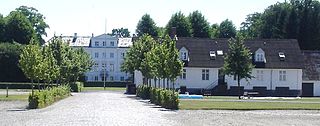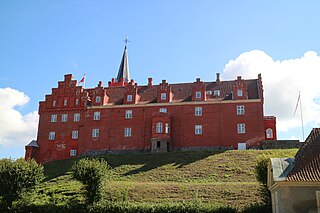
Princess Alexandra of Sayn-Wittgenstein-Berleburg, Countess Ahlefeldt-Laurvig-Bille, is the first daughter and second of three children of Prince Richard of Sayn-Wittgenstein-Berleburg and Princess Benedikte of Denmark, sister of two Queens, Margrethe II and Anne-Marie of Greece.

Michael Preben, Count Ahlefeldt-Laurvig-Bille is a Danish Count and a landowner. By birth he is a member of an ancient German House of Ahlefeldt.

Eriksholm Castle is a manor house located at the foot of the Isefjord inlet, 6 km south-east of Holbæk, in east Denmark. The history of the estate dates back to 1400 but today's house was built in 1788 to a Neoclassical design by Caspar Frederik Harsdorff, the leading Danish architect of the time. It was listed in the Danish registry of protected buildings and places in 1918.

Rosenfeldt Manor is a manor house and estate located just west of Vordingborg, Vordingborg Municipality, some 90 km south of Copenhagen, Denmark. One of 12 new manors created when Vordingborg Cacalry District was dissolved in 1774, its first owner was Reinhard Iselin. The current main building was constructed for Oscar O'Neill Oxholm in 1870 to a design by Henrik Steffens Sibbern.

Reinhard Iselin was a Danish merchant, shipowner and industrialist who founded Reinhard Iselin & Co. in Copenhagen in 1749. The company completed 65 expeditions to the Danish West Indies. Iselin was also active in the Danish Asiatic Company where he served on the board of directors from 1759 to 1769. He owned Iselingen and Rosenfeldt at Vordingborg. He was raised to the peerage with the rank of baron in 1776 but the title died with him since both his sons died as infants.

Just Michael Aagaard was a Danish merchant and konditori-owner in Copenhagen. He served as chair of the Council of 32 Men and was director of Kjøbenhavns Brandforsikring. He was the father of Holger Halling Aagaard and owned Iselingen at Vordingborg from 1806.

Egholm is a manor house and estate situated on the Hornsherred Peninsula, between Kirke Hyllinge and Skibby, in Lejre Municipality, some 60 km west of Copenhagen, Denmark. The Neoclassical main building from 1824, a gatehouse from 1870, a barn from 1880, a stable from circa 1890 and a former horse mill were listed on the Danish registry of protected buildings and places in 1998. Another building is now operated as an arms museum under the name Egholm Museum. The estate covers 770 hectares of land.

Løvenborg is a manor house and estate at Holbæk, Denmark.

The Countship of Larvik aka Landgraviate of Larvik was created on 29 September 1671 when Brunla amt was made into the county of Laurvigen. It covered today's Larvik and Tjøme municipality, and parts of Sandefjord municipality.
Højbygård is a manor house and estate located on the island of Lolland in southeastern Denmark. It has since 1825 belonged to members of the Lehn family. The current main building is from the 18th century but has been altered several times.

Lilliendal is a manor house and estate located at Vordingborg in southeastern Denmark. The estate covers approximately 800 hectares of mostly farmland. Lilliendal was established by Hans Gustav Lillienskiold (1727–1796) in the 1760s and later owned by the Knuth family for almost two hundred years from the 1800s to 1994. A relatively small main building from 1765 was expanded in the 1850s and again in 1919.

Martin Johannes Hammerich was a Danish art historian, educator, author, and translator. He was part of the National Liberal movement and a member of the 1848 Danish Constituent Assembly. He was headmaster of Borgerdydskolerne from 1842 to 1867.

Høvdingsgård is a manor house and estate located just east of Mern, Vordingborg Municipality, Denmark. The Late Neoclassical, two-storey main building is from 1852 but was widened in 1901. Anders Lassen, the only non-Commonwealth recipient of the British Victoria Cross in the Second World War, was born on the estate in 1920.
Avnøgård (Avnø), is a manor house and estate located in Vordingborg Municipality, Denmark. The estate was acquired by the Ministry of Defence in 1836 and turned into an airfield, Flyvestation Avnø. It was decommissioned when the airbase moved to Karup in 1993. Part of the estate is now the site of a nature centre, Naturcenter Avnø.

Snertingegård, also known simply as Snertinge, is a manor house and estate located just north of Vordingborg, in southeastern Denmark. It was one of 12 manors established after Vordingborg Cavalry District was dissolved in 1774. The Renaissance Revival style main building and home farm were built for Defence Minister Christian Frederik Hansen in 1857 from designs by Ferdinand Meldahl. Both buildings were listed on the Danish registry of protected buildings and places in 1978.
Jens Lind was a Danish sea captain, ship-owner, merchant, slave trader, landowner and industrialist. He was from the late 1780s until 1806 active in the Triangle Trade and was as such responsible for the shipment of somewhere between 1,800 and 2,000 slaves from Guinea to the Danish West Indies, approximately half of them illegally after the abolition of the trans-atlantic slave trade in 1803. He was from around 1800 also involved in a substantial number of industrial enterprises, including a brewery at Vandkunsten 8 in Copenhagen and a paper mill, oil mill and soap factory on the Hulemose estate at Vordingborg.

Marienlyst Manor is a manor house and estate located on the southernmost part of Zealand, overlooking the Færgestrøm, Vordingborg Municipality, in southeastern Denmark. Formerly a farm under Iselingen, it was incorporated as an independent manor in 1810. The main building dates from 1800 but owes its current appearance to a renovation undertaken after a fire in 1873.

Iver Qvistgaard was a Danish civil servant, landowner and mayor of Copenhagen. He owned Aagaard Manor at Holbæk and the country house Wesselsminde at Nærum. He also engaged in a number of other speculative investments on the turbulent property market during the Napoleonic Wars.

Hans Wassard was a Danish merchant, landowner and one of Copenhagen's 32 Men. He invested in a number of privateer ships during the Gunboat War. He owned Marienlyst Manor at Vordingborg.

Tranekær Manor(Danish: Tranekær Gods) is a manor house and estate on Langeland, Denmark. The red-plastered, two-winged main building is perched on a small hill on the northern outskirts of the village Tranekær. It originates in a four-winged Medieval castle of which the south and east wings were demolished in the 1720s. It owes its current appearance to a comprehensive renovation undertaken by the architect Niels Sigfred Nebelong in 1859–1863. The main building, a theatre building, a stable, a carriage house and a garden pavilion were listed on the Danish registry of protected buildings and places in 1918. Tranekær has belonged to members of the Ahlefeldt family since 1659.
























